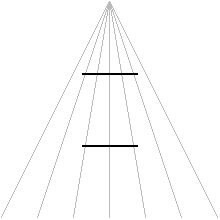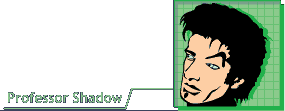
“The image to the left illustrates the Ponzo illusion. The Ponzo illusion uses depth cues, such as converging lines, to suggest distance in a visual image. Rather than seeing the gray lines as a bunch of marks on a flat screen, our visual system interprets them as parallel lines that project out to the horizon. If you were standing on a railroad track, the two parallel rails appear to converge as they rise toward the limits of your vision. Just make sure there aren’t any trains coming while you are looking!
“When the gray lines are present, implying that parallel lines are converging at a distance, the upper black bar appears to be longer than the lower. However, when the lines vanish, we see that the bars are actually equal in length.
“Our visual system naturally compensates for size estimations according to distance. The Ponzo illusion exploits that natural process. If two objects have the same visual size but one is farther away, the more distant object is larger. It appears we are looking along gray lines converging at the horizon. Thus, the upper bar appears to be farther away from us. Because it has the same visual size as the ‘closer’ bar, our visual system interprets the upper bar to be longer than the lower one.”
